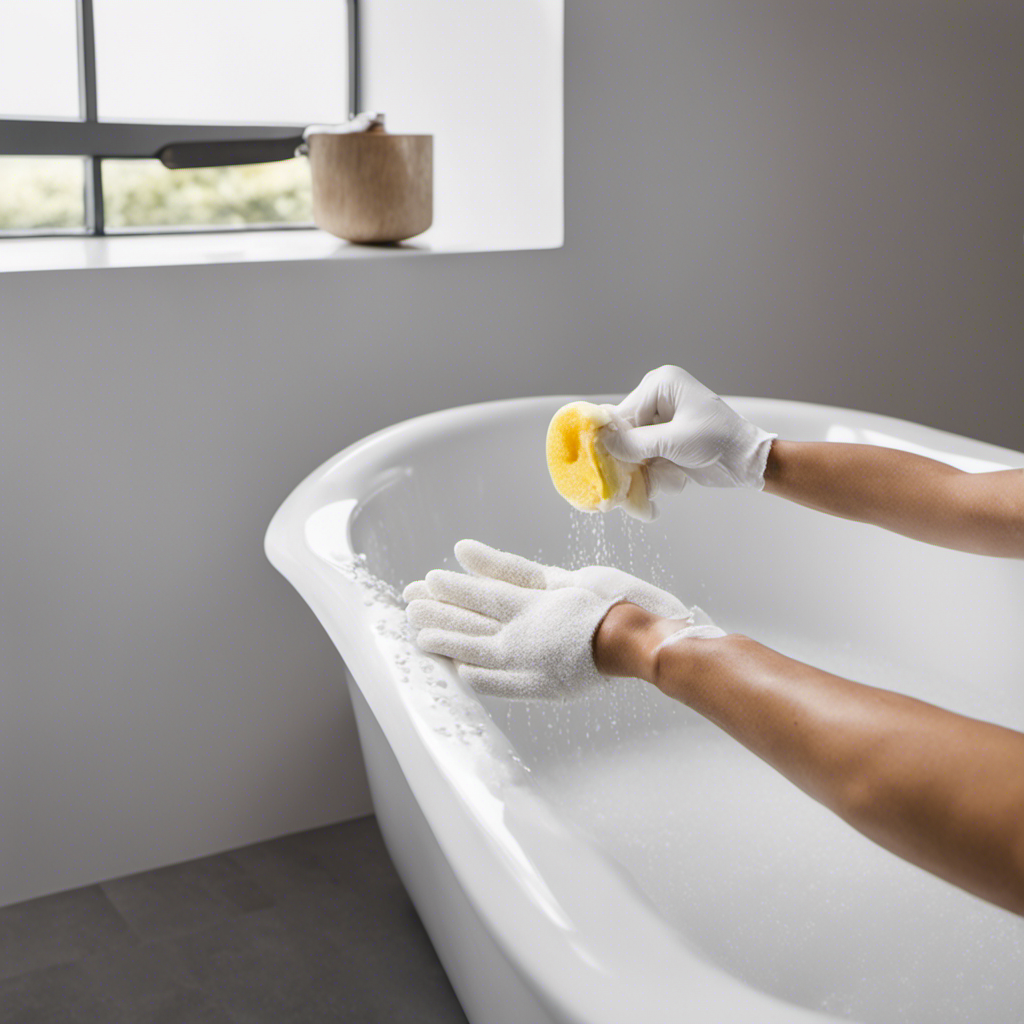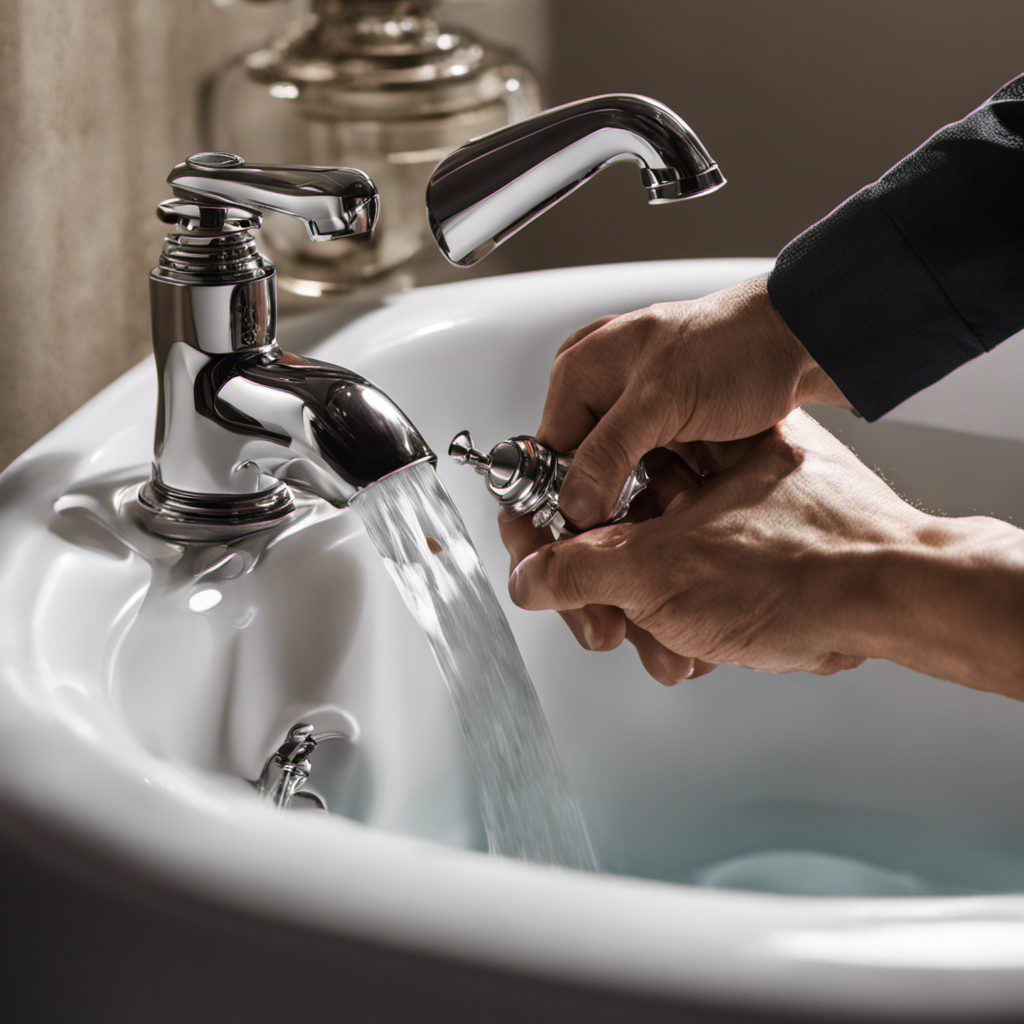Hey there! So, you’re dealing with those pesky stains in your bathtub, huh? Well, fear not my friend, because I’ve got you covered.
In this article, I’ll be sharing some tried and tested methods to get those stubborn stains out of your tub. From homemade solutions to commercial stain removers, I’ll walk you through each step of the process.
So, get ready to say goodbye to those unsightly stains and hello to a sparkling clean bathtub! Let’s dive in, shall we?
Key Takeaways
- Use vinegar, baking soda, or hydrogen peroxide to break down bathtub stains.
- Wipe down the tub after each use and use a shower curtain or mat for protection.
- Regularly clean the bathtub surface with non-abrasive cleaners.
- Take preventive measures such as using a squeegee or towel to remove excess water and prevent water spots.
Types of Stains in Bathtubs
You’re probably wondering about the different types of stains you might find in your bathtub. Well, let me enlighten you.
There are several common types of bathtub stains that can be a real headache to remove. The most common ones are rust stains, hard water stains, soap scum, and mold and mildew stains.
Rust stains are usually caused by metal objects left in the tub, while hard water stains occur due to mineral deposits. Soap scum is a result of soap residue mixing with water, and mold and mildew stains are caused by moisture and lack of ventilation.
To remove tough stains, you can try using a mixture of baking soda and vinegar, or a commercial stain remover.
Now that you know about the types of bathtub stains and how to remove them, let’s move on to the common causes of these stubborn stains.
Common Causes of Bathtub Stains
To understand what causes those stubborn stains in your bathtub, it’s important to identify common culprits. Here are some common causes of bathtub discoloration:
- Hard water: The minerals in hard water can leave behind unsightly stains on your bathtub surface.
- Soap scum: Soap residue can build up over time and create a film on your bathtub, leading to discoloration.
- Mold and mildew: These fungi thrive in damp environments, and if left untreated, can cause stains on your bathtub.
Knowing the causes of bathtub stains is the first step to removing them. To tackle hard water stains, try using a mixture of vinegar and water or a commercial descaler. For soap scum, a mixture of baking soda and water can be effective. Mold and mildew can be treated with a bleach solution or a specialized mold cleaner. Remember to follow the manufacturer’s instructions and test any cleaning solutions on a small, inconspicuous area before applying them to the entire bathtub surface.
Preparing the Bathtub for Stain Removal
When it comes to preparing the bathtub for stain removal, it’s important to know which cleaning products to use. Some effective options include vinegar, baking soda, and hydrogen peroxide. These products can help break down soap scum and other stains, making them easier to remove.
Additionally, taking preventive measures can help minimize future stains, such as wiping down the tub after each use and using a shower curtain or mat to protect the surface.
Cleaning Products to Use
If you want to effectively remove stains from your bathtub, consider using a combination of vinegar and baking soda. These homemade cleaning solutions are not only effective but also eco-friendly alternatives to harsh chemical cleaners.
Here are three reasons why vinegar and baking soda are great for cleaning your bathtub:
-
Vinegar:
-
It has natural antibacterial properties, making it effective in removing dirt, grime, and stains.
-
It helps dissolve soap scum and hard water deposits, leaving your bathtub sparkling clean.
-
Vinegar is a non-toxic cleaner, making it safe for you and the environment.
-
Baking Soda:
-
It acts as a mild abrasive, gently scrubbing away tough stains without scratching the surface of your bathtub.
-
Baking soda neutralizes odors, leaving your bathtub smelling fresh and clean.
-
It is a natural deodorizer and can help eliminate any unpleasant smells in your bathroom.
Removing Soap Scum
One way you can effectively remove soap scum from your bathtub is by using a combination of vinegar and baking soda. This homemade cleaning solution is not only eco-friendly, but it also works wonders on tough stains. To create this powerful mixture, simply sprinkle baking soda onto the soap scum and then spray vinegar over it. Let it sit for a few minutes before scrubbing with a sponge or brush. The foaming reaction between the vinegar and baking soda helps to break down the soap scum, making it easier to remove. Here is a table that compares the benefits of using homemade cleaning solutions and eco-friendly stain removers:
| Homemade Cleaning Solutions | Eco-Friendly Stain Removers |
|---|---|
| Cost-effective | Chemical-free |
| Environmentally-friendly | Safe for pets and kids |
| Easily accessible | Biodegradable |
Preventing Future Stains
Now that you know how to remove soap scum from your bathtub, let’s talk about preventing future stains. Regular maintenance and proper ventilation are key to keeping your bathtub clean and stain-free. Here are some tips to help you in this process:
- Clean your bathtub regularly using a non-abrasive cleaner.
- Wipe down the surfaces after each use to prevent build-up.
- Use a squeegee or towel to remove excess water and prevent water spots.
By following these steps, you can ensure that your bathtub stays clean and free from unsightly stains.
Now, let’s move on to the next section where we will discuss homemade stain removal solutions.
Homemade Stain Removal Solutions
There’s a homemade solution to remove stains from your bathtub.
When it comes to natural stain removal methods, there are several DIY stain removal techniques that can be effective.
One popular method involves using a mixture of baking soda and hydrogen peroxide. Simply create a paste by combining the two ingredients, apply it to the stained area, and let it sit for a few hours before scrubbing it off.
Another option is to use vinegar and lemon juice. These natural acids can help break down stubborn stains. Just mix equal parts vinegar and lemon juice, apply it to the stain, and let it sit for a while before rinsing it off.
With these homemade solutions, you can easily tackle bathtub stains without the use of harsh chemicals.
However, if these methods don’t work, you may want to consider using commercial stain removers for a more powerful solution.
Using Commercial Stain Removers
To effectively remove stubborn stains, you should consider using commercial stain removers, which can provide a more powerful solution. These products are specifically designed to tackle tough stains and can often be more effective than homemade remedies.
Here are a few reasons why commercial stain removers can be a great option:
-
Enhanced Formulas: Commercial stain removers are developed with advanced formulas that are specifically designed to break down and lift stubborn stains.
-
Targeted Action: These products are formulated to target specific types of stains, such as rust, soap scum, or hard water deposits, ensuring effective stain removal.
-
Time-saving: Commercial stain removers often require less scrubbing and soaking time compared to alternative methods, making the cleaning process quicker and more efficient.
While alternative stain removal methods can be useful for minor stains, when dealing with stubborn and deep-set stains, commercial stain removers are often the most effective solution.
Scrubbing Techniques for Stubborn Stains
You’ll find that using a circular motion while scrubbing can help loosen stubborn stains and make them easier to remove.
When it comes to getting rid of tough stains in your bathtub, homemade stain removers can be highly effective cleaning products. One popular homemade stain remover is a mixture of baking soda and hydrogen peroxide.
Simply create a paste by combining equal parts of these two ingredients, then apply it to the stain and let it sit for a few minutes. After that, take a scrub brush and start scrubbing in circular motions. This technique helps to break down the stain and lift it from the surface of the bathtub.
Remember to rinse thoroughly after scrubbing to remove any residue. With this simple and effective cleaning method, you can say goodbye to stubborn bathtub stains.
Preventing Future Stains in the Bathtub
When it comes to preventing future stains in the bathtub, there are a few key points to keep in mind.
First, establishing a regular cleaning routine is crucial in maintaining a clean and stain-free tub.
Using protective mats is also highly recommended, as they create a barrier between the tub and any potential stains.
Lastly, it’s important to avoid using harsh chemicals, as they can not only damage the surface of the tub but also cause discoloration over time.
Regular Cleaning Routines
Maintaining a regular cleaning routine will help keep your bathtub free of stains. By following a few simple steps, you can ensure that your bathtub stays sparkling clean. Here are some tips for regular maintenance and deep cleaning:
Regular Maintenance:
- Wipe down your bathtub after each use with a sponge or cloth to remove any soap scum or residue.
- Use a bathtub cleaner specifically designed for your type of bathtub material to prevent damage.
- Dry the bathtub thoroughly to prevent water spots and mineral buildup.
Deep Cleaning:
- Once a month, give your bathtub a deep clean by using a mixture of baking soda and vinegar to remove stubborn stains.
- Scrub the bathtub with a soft brush or sponge to remove any dirt or grime.
- Rinse the bathtub thoroughly with water to remove any residue.
Using Protective Mats
Using protective mats in your bathtub can help prevent scratches and damage to the surface. They provide a protective barrier and offer other benefits.
First, mats help keep your bathtub clean by trapping dirt and debris, making it easier to clean.
Second, they provide a non-slip surface, reducing the risk of accidents in the bathroom.
When choosing the right protective mat for your bathtub, consider the material, size, and design. Look for mats made of durable materials like rubber or silicone, as they are resistant to water and can withstand regular use.
Additionally, opt for a mat that fits your bathtub perfectly to ensure maximum coverage.
By using a protective mat, you can prolong the life of your bathtub and maintain its pristine condition.
Now, let’s discuss how to avoid harsh chemicals in cleaning your bathtub.
Avoiding Harsh Chemicals
To keep your bathtub in great condition, it’s important to avoid harsh chemicals when cleaning. Using natural alternatives and eco-friendly options not only protects the environment but also ensures the longevity of your bathtub. Here are some tips on how to clean your bathtub without using harsh chemicals:
-
Baking Soda and Vinegar:
Mix equal parts of baking soda and vinegar to create a paste. Apply the paste to the stains in your bathtub. Let it sit for a few minutes, then scrub with a brush and rinse thoroughly. -
Lemon Juice:
Squeeze fresh lemon juice onto the stains. Let it sit for a few minutes, then scrub and rinse. Lemon juice is great for removing soap scum and hard water stains. -
Hydrogen Peroxide:
Mix hydrogen peroxide with water in a 1:1 ratio. Apply the solution to the stains and let it sit for a few minutes. Scrub and rinse to reveal a sparkling clean bathtub.
Tips for Removing Rust Stains
If you want to get rid of rust stains in your bathtub, start by applying a mixture of vinegar and baking soda. This combination works wonders in removing rust stains effectively. Simply make a paste by mixing equal parts of vinegar and baking soda, then apply it directly to the rust stains. Let it sit for about 30 minutes, then scrub the area with a soft brush or sponge. Rinse thoroughly with water and repeat if necessary.
To prevent future rust stains, make sure to keep your bathtub dry and avoid leaving metal objects or containers in the tub for extended periods of time.
Now, let’s move on to dealing with hard water stains in your bathtub.
Dealing With Hard Water Stains
Now that we’ve covered how to remove rust stains from your bathtub, let’s tackle another common issue: hard water stains. Dealing with hard water stains can be frustrating, as they often leave behind mineral deposits that can be tough to get rid of. However, with the right techniques and products, you can restore your bathtub to its original shine.
Here are some effective methods for dealing with hard water stains:
-
Use white vinegar: Vinegar is a natural cleaning agent that can break down mineral deposits. Simply mix equal parts vinegar and water, apply it to the stained area, and let it sit for a few minutes before scrubbing with a brush.
-
Try lemon juice: Lemon juice has similar properties to vinegar and can be just as effective in removing hard water stains. Squeeze fresh lemon juice onto the stains and let it sit for a while before scrubbing.
-
Consider using a commercial cleaner: If the stains are particularly stubborn, you may need to use a commercial cleaner specifically designed for hard water stains. Look for products that contain citric acid or phosphoric acid, as these ingredients are effective in breaking down mineral deposits.
Removing Soap Scum and Mildew
When it comes to removing soap scum and mildew, it’s important to have the right cleaning products on hand. Effective cleaning products like vinegar, baking soda, and hydrogen peroxide can help break down the grime and eliminate odors.
Along with using these products, employing scrubbing techniques that work, such as using a brush or sponge with a bit of elbow grease, can ensure a thorough clean.
Effective Cleaning Products
You’ll need some effective cleaning products to remove those stubborn stains from your bathtub. When it comes to choosing the right products, there are a few options to consider. Here are some factors to think about:
-
Homemade vs. Commercial Products: Homemade cleaning products can be a cost-effective option, using ingredients like vinegar, baking soda, and lemon juice. They are natural and environmentally friendly. On the other hand, commercial products are specifically formulated to tackle tough stains and may contain stronger chemicals.
-
Natural vs. Chemical Cleaning Options: Natural cleaning products are becoming increasingly popular due to their non-toxic nature. They use ingredients like essential oils and plant-based enzymes to break down stains. Chemical cleaning options, on the other hand, are often more powerful and can be effective for deep-seated stains.
-
Specific Stain Removers: Depending on the type of stain you have, there are specific products available. For example, rust removers are great for dealing with rust stains, while bleach-based cleaners work well for mold and mildew.
Consider these factors when choosing your cleaning products to effectively remove stains from your bathtub.
Scrubbing Techniques That Work
Using a circular motion and a scrub brush, I gently work the cleaning product into the surface of my bathtub to effectively remove stubborn stains. But what are other effective scrubbing techniques that can help get rid of those pesky stains? Here are some techniques that have worked for me:
| Technique | Steps |
|---|---|
| Baking Soda Paste | 1. Mix baking soda and water to form a paste. |
| 2. Apply the paste to the stained areas. | |
| 3. Let it sit for 15-20 minutes. | |
| 4. Scrub with a brush and rinse thoroughly. | |
| Vinegar and Lemon | 1. Mix equal parts vinegar and lemon juice. |
| 2. Spray or apply the mixture to the stains. | |
| 3. Allow it to sit for 30 minutes. | |
| 4. Scrub and rinse off the mixture. | |
| Hydrogen Peroxide | 1. Pour hydrogen peroxide directly onto the stains. |
| 2. Let it sit for 30 minutes. | |
| 3. Scrub and rinse thoroughly. | |
| Salt and Vinegar | 1. Create a paste using salt and vinegar. |
| 2. Apply the paste to the stained areas. | |
| 3. Let it sit for 30 minutes. | |
| 4. Scrub and rinse off the paste. |
These techniques have proven to be effective in removing stains using natural ingredients. Experimenting with different methods can help find the best solution for your bathtub. Remember to always test on a small area first and wear gloves to protect your hands. Happy scrubbing!
Preventing Future Buildup
Now that we’ve discussed effective scrubbing techniques, let’s talk about how to prevent future buildup in your bathtub. By implementing a few simple strategies, you can keep your tub looking clean and stain-free for longer.
Here are some tips:
-
Apply a protective barrier: After thoroughly cleaning your bathtub, consider applying a protective barrier such as a wax or sealant. This will create a barrier between the surface of your tub and potential stains, making it easier to clean in the future.
-
Use natural cleaning solutions: Regularly clean your bathtub with natural cleaning solutions, such as vinegar or baking soda. These eco-friendly alternatives are effective at removing dirt and grime without causing damage to your tub’s surface.
-
Establish a cleaning routine: Develop a regular cleaning routine to prevent stains from building up. By regularly wiping down your tub and removing any soap scum or residue, you can avoid the need for more intensive stain removal methods later on.
By following these preventive measures, you can maintain a clean and stain-free bathtub.
However, if you do encounter stubborn stains on acrylic and fiberglass tubs, don’t worry! In the next section, we’ll explore effective stain removal techniques specifically for these types of tubs.
Stain Removal for Acrylic and Fiberglass Bathtubs
Stain removal for acrylic and fiberglass bathtubs can be achieved with a mixture of baking soda and vinegar. This homemade stain remover is effective and easy to make. Simply mix equal parts baking soda and vinegar to form a paste.
Apply the paste to the stained areas of your bathtub and let it sit for about 30 minutes. Then, scrub the surface with a non-abrasive sponge or cloth. Rinse thoroughly with water and enjoy your clean bathtub.
If the homemade stain remover doesn’t work, you can try using a commercial stain remover specifically designed for acrylic and fiberglass surfaces. Follow the instructions on the product carefully and test it on a small, inconspicuous area first to ensure that it doesn’t damage your bathtub.
Frequently Asked Questions
Can I Use Bleach to Remove Stains From My Bathtub?
Yes, you can use bleach to remove stains from your bathtub. However, if you prefer bleach alternatives or natural stain removers, there are several options available that can be just as effective.
How Long Do I Need to Let the Homemade Stain Removal Solution Sit Before Scrubbing?
To effectively remove stains from a bathtub, it’s important to make a homemade stain removal solution. Vinegar can be used as a powerful cleaner. After applying the solution, let it sit for a while before scrubbing for best results.
Can I Use a Scrub Brush to Remove Stains From an Acrylic Bathtub?
Sure, you can use a scrub brush to remove stains from an acrylic bathtub. However, there are alternative stain removal methods, like using baking soda or vinegar, that are gentler on the surface.
What Is the Best Way to Remove Stubborn Rust Stains From a Bathtub?
The best way to remove stubborn rust stains from a bathtub is by using the right rust removers or natural stain removal methods. It’s important to find a solution that works effectively and doesn’t damage the bathtub surface.
How Often Should I Clean My Bathtub to Prevent Future Stains?
To keep my bathtub stain-free, I need to know how often I should use a bathtub cleaner. Additionally, I should explore natural cleaning solutions for bathtub stains to maintain its cleanliness and shine.
Conclusion
In conclusion, removing stains from a bathtub can be a challenging task, but with the right knowledge and techniques, it can be easily accomplished.
From homemade solutions to commercial stain removers, there are various options available to tackle different types of stains.
Whether it’s rust stains, hard water stains, soap scum, or mildew, there are specific methods to effectively eliminate each type of stain.
It’s important to properly prepare the bathtub before applying any stain removal solution and to follow the instructions carefully.
With these tips and tricks, you can have a clean and spotless bathtub in no time.










